Notes from the editor
ACCC in the conservation matrix
Arun Kumar was the first intern I met at the ACCC back in 2007. He was a post graduate in business administration and wanted to see if he could pursue ecology as a career. Such an intention did not surprise me as many well-known conservation scientists have received diverse training. Arun carried out a small study in Kolundumamalai hills just outside the tiger reserve but eventually decided that he will not take up conservation science as a career. Nevertheless, he is proactive in dealing with conservation issues in Rajapalayam, T amil Nadu and also volunteers for several conservation initiatives in KMTR and other forested regions. Reading the articles in this issue, I realise that every time I visited the ACCC, I met a new intern or witnessed some training program. The diversity of the people who I have come across at the ACCC is quite startling. I have met journalists, lawyers, doctors, engineers, farmers, industrialists, priests, politicians, officers from the Indian Army and Navy, Forest department officials, Police officers and people from many other fields in addition to students. The students are from countries such as U.K, U.S.A, France, Norway, Ireland as well as from local institutions such as the agriculture college in Killikulam. Conservation decisions have long been made by a few elites but we believe that long term success can be achieved only if people from different walks of life get involved in it. ACCC, by facilitating research and conservation action for a global, regional and local start-ups and aspirants, attempts to play its little role in strengthening the conservation thinking both in the landscape and beyond.
- Allwin Jesudasan
Why? What? & How? of an SMS based monitoring system
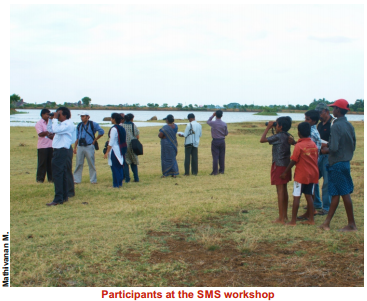 Low cost Short Messaging
Services (SMS) has become a way
of life even in the most remote
villages of India.
We cashed in on this facility and
popularity and put together an SMS
based biodiversity monitoring
system. This low cost short
message services was test run in
the buffer area of KMTR by our
team for the first time in 2011
whereby we targeted a wide
audience comprising of college and
school students, teachers and
people from various other walks of
life. A group of thirty odd people
participated enthusiastically in the
two day event to pick up skills on
identifying flora and fauna and also on
messaging and coding to simplify the
process of transmitting information .
Currently, as we make efforts to re-design
and develop this monitoring program, the
following thoughts come to our mind.
Why? Is it really a programme that has
worked in the west or an urban area and finds
little relevance in a rural setting? The buffer
area of KMTR in fact is densely populated
with many busy towns and villages and home
to a lot of young school and college goers.
Then, is the idea of documenting flora and
fauna inherent to a commoner or a student?
Today it is being increasingly realised that
bunch of urban wildlife enthusiasts who visit
the area to record biodiversity changes can
not be sustained for a long period time. With
proper training and quality control, such
programs can potentially generate high
quality ecological data. In fact, the rich long
term butterfly data that UK boasts of today
has been collected by laypersons. It is here
that we arrive at the “What?” of the
programme. Popular floral and
faunal taxa from the perspective of
ecosystem services and
environmental education have
been considered, but the possibility
of including short message alerting
systems to report farmland cropraids by wildlife, or report wildlfires
were also debated.
How can this be done? From the
proceedings of the seminar on
Citizen Science held during Jan
2013 at ATREE, it was quite clear
that similar programmes and
facilities put into their place by the
help of back end technology alone
was not enough to dri ve such
initiatives. Back-end technology may not be
hard to furnish but the need for constant
interaction with enthusiastic participants by
the facilitators will be critical for one such
initiative to blossom. Hands-on interactive
sessions and capacity building with inputs on
the possible services and utilities of such
initiatives were suggested as the need of the
hour for such programme to meet their
requirements.
Low cost Short Messaging
Services (SMS) has become a way
of life even in the most remote
villages of India.
We cashed in on this facility and
popularity and put together an SMS
based biodiversity monitoring
system. This low cost short
message services was test run in
the buffer area of KMTR by our
team for the first time in 2011
whereby we targeted a wide
audience comprising of college and
school students, teachers and
people from various other walks of
life. A group of thirty odd people
participated enthusiastically in the
two day event to pick up skills on
identifying flora and fauna and also on
messaging and coding to simplify the
process of transmitting information .
Currently, as we make efforts to re-design
and develop this monitoring program, the
following thoughts come to our mind.
Why? Is it really a programme that has
worked in the west or an urban area and finds
little relevance in a rural setting? The buffer
area of KMTR in fact is densely populated
with many busy towns and villages and home
to a lot of young school and college goers.
Then, is the idea of documenting flora and
fauna inherent to a commoner or a student?
Today it is being increasingly realised that
bunch of urban wildlife enthusiasts who visit
the area to record biodiversity changes can
not be sustained for a long period time. With
proper training and quality control, such
programs can potentially generate high
quality ecological data. In fact, the rich long
term butterfly data that UK boasts of today
has been collected by laypersons. It is here
that we arrive at the “What?” of the
programme. Popular floral and
faunal taxa from the perspective of
ecosystem services and
environmental education have
been considered, but the possibility
of including short message alerting
systems to report farmland cropraids by wildlife, or report wildlfires
were also debated.
How can this be done? From the
proceedings of the seminar on
Citizen Science held during Jan
2013 at ATREE, it was quite clear
that similar programmes and
facilities put into their place by the
help of back end technology alone
was not enough to dri ve such
initiatives. Back-end technology may not be
hard to furnish but the need for constant
interaction with enthusiastic participants by
the facilitators will be critical for one such
initiative to blossom. Hands-on interactive
sessions and capacity building with inputs on
the possible services and utilities of such
initiatives were suggested as the need of the
hour for such programme to meet their
requirements.
-Prashanth M. B.
prashanth.mb@atree.org
Plant-animal interactions - PhD elective at the ACCC
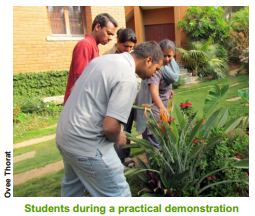
Plant - animal interactions (PAI) is an important field, which has grown in the past 40 years. In most places, this course is taught in a class-room setting leaving students imagination to run wild rather than 'un-wild'. Some hope that the interactions are taught will unfold right under their noses. This stems from the fact that it is taught with examples which have been well worked by field ecologists that perhaps took them prolonged observation varying from days to years. Some of these popular examples are archaic or from forests of other continents. Often, we fail to explore our own backyards to come up with case studies. I was determined to use ACCC's backdrop for PAI course, which is an arena for many such interactions. I took up the task of teachi ng PAI for conservation and sustainable use for graduate students of ATREE who undergo interdisciplinary courses which straddle issues across Ecology, Sociology, Anthropology, Economics to Political ecology . The students come from varied background and not all are trained in biology . However, by the time I offered my course, they were pretty much entrenched into issues of conservation and sustainability , almost like horses with blinkers trained to dive into articles which run to not less 100s of pages. Although, they were an enthused bunch who were here because of their innate fondness of wilderness, they now seemed to have lost their observational traits. In all, four out of the 16 students from the 2011 batch opted for my elective. The classes started in Bangalore with theoretical underpinnings of PAI, starting from mutualistic (pollination, dispersal) to antagonistic interactions (herbivory), the evolutionary and ecological perspectives , chemical and communication ecology of the interactions etc. The lone sociologist always caught me on my basics and kept me on my toes. Soon, the students were exposed to techniques of observation. In Bangalore, they were glued to a location for 6 hours to see which animals were visiting a fruiting fig tree and observing the dynamics of interactions among visitors that ensures seed dispersal away from tree. Once they were trained, we headed to the ACCC to pan out to various forest types to take up some actual field research. We were in the wet forests of Agasthyamalai, brainstorming on various research questions. Finally the group decided to work on patterns of herbivory in Macaranga peltata to test the apparency theory vis-à-vi s resource concent ration hypothesis. Soon, field methods were devised and the data generation started ensuring it is robust enough for statistical analysis. T oday we still are a cohesive group trying to complete a manuscript based on our course work. Thus, the PAI course can suit interdisciplinary as well ecological students to integrate natural and social sciences. To cite an example, the sociologist began drawing analogy between herbivory by beetles and beedi (rolled tobacco) leaves collection by humans on which he has been working on. He started integrating different writing styles of various disciplines which gets critical for student who takes up interdisciplinary approach for their thesis.
- M. Soubadra Devy
soubadra@atree.org
ACCC's internship programs beckons
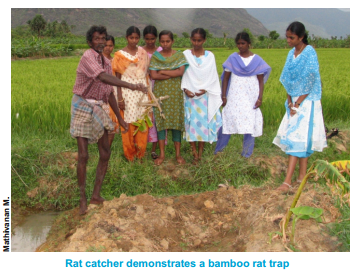
Agasthyamalai Community - based Conservation Centre (ACCC) is one of the field academies of ATREE. At the ACCC, we have been facilitating internship opportunities for students and interested individuals from India as well as from overseas countries for the past 10 years . Students from diverse backgrounds are encouraged to do the field based conservation science. The interns usually comeup with their own idea for research but some also assist ongoing research programs of the ACCC. So far more than 30 interns have worked in the ACCC carrying out research in diverse topics such as fuelwood study , water management issues, bat monitoring programs, bird surveys, people's perception on biodiversity , conservation education etc. The interns as well as the ACCC benefit through the internship program. Many interns have come here for their master's dissertation using the information provided by the ACCC. An intern from the United States had developed a protocol for monitoring fruit bats (flying fox) and phenology patterns of the trees for rural students which were followed-up by the Green Brigade (student club at ACCC). An intern from France worked on ecosystem services provided by owls in the paddy fields which gave baseline information for our research project. Two interns assisted in the bat surveys in temples which was part of an ongoing project at the ACCC. Through the internship opportunities, the interns share their knowledge with the stakeholders by publishing research papers, thesis and popular articles. ACCC also facilitates courses for college and university students in the region as well as from abroad. Every year, students from the Tamil Nadu Agricultural University ( TNAU) , Killikulam come to the ACCC for their program, Rural Agricultural Work Experience (RAWE). The students are trained in ecology and they assist in our ongoing programs. Through this opportunity the students learn the linkages between forests and agriculture such as rodent control by owls and pest control by bats and other birds etc. At the ACCC, we provide good accommodation , vehicle , field assistants, field equipments among other forms of support and assistance. There are still many things that have to be explored in Agasthyamalai region and we encourage people to apply for internship at the ACCC.
- M. Mathivanan
mathi@atree.org
Around KMTR in eight days
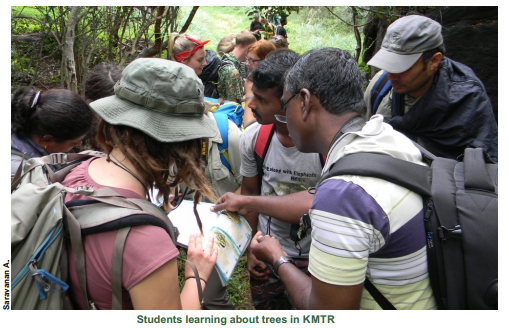
Our group of 12 undergraduate students from the University of Kansas had explored much of Southern India with the help of our ATREE hosts. Now we began our last leg of journey to KMTR on June 23rd. Amazingly friendly ATREE staff was a great energizer after the long journey . After some introductory lectures on the area and the conservation issues of the landscape, we were all set for some hiking. After trekking for eight km we reached the Naraikkadu guest house where we learnt more about its history and also sighted two rare primates, Niligiri langur and the liontailed macaque which are endemic to the Western Ghats. We stayed the night and awoke to spectacular sunrise view before heading back down to the field station. On the26th with our legs rested, we drove up to the wet evergreen forests of KMTR to learn about canopy study . We took turns practicing the single rope climbing method. Although all of us did not scale beyond 5 mts from the ground we still were able to see the landscape from a new perspective. When we were not in the treetops, we conducted small individual research projects. The next morning we began our cultural exploration of the KMTR area with a visit to Thirupadai Maruthur temple. The temple was being renovated leading to repainting of gods and goddesses in bright, stunning colors. We enjoyed exploring the nearby bird conservation reserve, although we were not in the right season for birds. Nevertheless we saw Indian fruit bats at close quarters. After our walk, we visited the caretaker of the sanctuary . He walked us through struggles and challenges he had to endure to protect the nesting birds and bats. Our cultural exploration of KMTR continued into the afternoon when we saw traditional mat weaving looms. Women split and stitched sedge (Cyperus pangorai) fibers to create mats traditionally presented for weddings, and other handmade products. Later, we were outfitted with new ATREE tshirts and went to a street performance of music, dance and skits designed to educate village children and their parents on the importance of protecting the environment. Our week in KMTR packed with hikes, plays, and lectures was an excellent time and a wonderful way for us to end our time in India.
- Chris Rice and Katie Stites
c120r853@ku.edu
Nature as the teacher
After a long, strenuous hike up the mountain, we summited on the porch of the Jewel House collapsing out of breath. Our breath was taken away once again when we first gazed out onto the plains below. While far off in the distance we could see the lights from villages and towns in the plain, we felt a sense of tranquillity cradled by the mountains. The Jewel House is one of three jungle bungalows located in Naraikkadu, the property privately- owned by Dohnavur Fellowship in the midst of the Kalakkad Mundanthurai Tiger Reserve. During our stay , we sat down with Ezekiel Devairakkan, on the porch of the Jewel House to discuss the history and conservation role of Dohnavur Fellowship. He spoke passionately of Amy Carmichael and her missionary work in the early part of the 20th century. After an encounter with a six year old girl who had been given away by her family to a temple, Amy realized that there was a need to provide these orphans with a safe-haven. As her orphanage grew, Amy continuously incorporated nature studies into the children's curriculum and searched for a summer home where they could be immersed in nature. The forty-acre former coffee estate was purchased in 1917 and the construction of the Jewel House, in which we stayed, was completed in 1932. The property is still solely run by Dohnavur fellowship and their descendants and the bungalows still serve as a summer retreat . Upholding Carmichael's naturalistic philosophy, all visitors must follow the Dohnavur policy by respecting and protecting the land. Dohnavur Fellowship maintains a close relationship with the Forest Department acting as stewards of the land, they protect the wildlife by not altering the landscape too much. The six kilometer hike to the houses along the Naraikkadu Trail is an education in itself and makes the final breathtaking view ever more rewarding. Our stay at Naraikkadu allowed us to recognize the sheer significance and overwhelming power that nature beholds.
- Ida Greenwell and Erin Dougherty
i486g529@ku.edu
Nature based education: a boy's view
George Varghese Abraham is an eighteen
year old boy from Kerala aspiring to become
a doctor. Both of his parents are missionary
dentists affiliated with the Dohnavur
Fellowship. The Dohnavur Fellowship
provides many services, one of which is an
orphanage for young girls founded by the late
Amy Carmichael of Ireland. Twice a year, in
May and September, the girls venture out to
the Naraikkadu retreat within Kalakkad
Mundanthurai Tiger Reserve (KMTR). This is
where we had the pleasure of meeting
George. He has witnessed the importance of
outdoor education for these young girls and
believes it provides them with an idea of what
conservation really is. The Fellowship
teaches that nature is a “holy place that
should not be defiled”. George believes that
children who have not been taught the
importance of the environment don't have the
same outlook towards conservation and
preservation. Even top education institutions
teach ecology within walls .The girls who visit
the lodge walk away with a stronger
connection to the natural world and a greater
desire to protect it. When we asked George
why he felt this secluded place was good for
outdoor education, he said it was due to the
beauty of KMTR. When sitting on the porch of
the Jewel Lodge looking out at the vast
expanses of forest, misty blue peaks, and
cascading waterfalls, it is easy to see why
George feels this way. Although the location
of the Fellowship's lodge is ideal for
enjoyment of the forest, it is situated in a Tiger
Reserve. The Fellowship has been allowed to
maintain ownership of the land due to its
effective management of the natural
environment. They act as a perfect example
of a non - governmental organization
successfully functioning within a protected
area.
The Fellowship has been an existence for
almost one-hundred years and has educated
countless young women on the importance of
the environment. Hopefully, with the help of
people like George who see the value in
outdoor education, the lodge's doors will stay
open for another one-hundred years.
- Gabrielle Murnan and Katelyn Whitt
murnang@gmail.com
Building capacity - The A TREE way
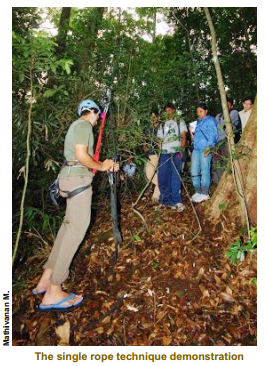
ATREEhas over the years held a certificate course in Conservation Sciences that has been a stepping stone for many a student interested in making a career as a conservationist. Six such courses have been held till date, with a few in the north-east and at Bangalore and BRT sanctuary . Unmindful of background or disciplinary training, the course has provided its participants with perspectives , concepts and tools to understand and work on regional conservation issues. I was fortunate to be a part of organizing team on one such course back in 2010 in Bangalore and at the then newly minted Agasthymalai CCC. This field based course in Conservation Science, an initiative of the Academy for Conservation Science and Sustainability Studies, was supported by Jamsetji Tata Trust. And its participants, an enthusiastic bunch of interior designers, physicists, engineers and biologists were exposed to on-the-ground conservation and research happenings at the ACCC. The field work had its share of excitement and apprehensions as for many this was their first experience to real world field setting. An integral component of the course was that the participants had to come with small projects that had conservation relevance for the region. The studies were varied and were based in the fringe villages around the CCC, the dry evergreen forests of the Tamaraparani and the wet evergreens at the mountain tops. A few participants persevered and have had their work published in peerreviewed journals. The alumini from the this course and its previous iterations are now pursuing their PhD's and master's degrees and are a cohort to watch out for .
- Vivek R.
vivekr@atree.org
Workshop on pollination for conservation and management
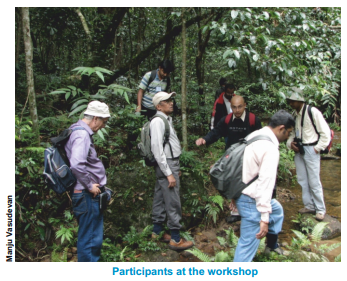
The disruption of pollination services can have disastrous consequences in terms of biodiversity loss and economic setbacks. Worldwide, there is recognition of looming pol l ination crisis and there has been a mobilization of efforts at several levels to address pollinator management and conservation. Although our country is rich in biodiversity with a large number of endemic species, our knowledge on their pollination biology is very meager. This is largely because of the lack of trained professionals. Thus realizing the importance of pollination biology and to spread its word, we organized a workshop on pollination biology for 7 days (7th to 13th Feb 2007) at ACCC. The main objective of conducting this workshop in a reserve forest is to have access to a diversity of flowering plants to conduct practicals, field demonstrations and small research projects. Professor Amots Dafni, a world renowned pollination biologist from the University of Haifa, Israel, conducted the workshop along with several experts from ATREE . Twenty research scholars from Universities and Research Organizations from different parts of the country participated in the workshop . Heartening indeed was to see a wide participation of the Forest Department staff, right from Field Director to numerous ground staff representatives. The workshop included morning lectures which were followed by practical demonstrations , and post - dinner discussions. All aspects were covered right from floral morphology and phenology (at the level of the flower , plant, population and the community), floral and plant sexuality , floral advertisements and rewards, pollination guilds, mutual adaptations between flowers and pollinators, distinction between floral visitors and pollinators and pollination efficiency . The lectures spread over the entire period of the workshop covered the concepts and in depth details on these areas of pollination biology . An important part of the workshop was the inception and execution of small research projects by the participants covering different aspects of pollination biology on a number of species that were in flowering. They devoted full time (07.00 h - 19.00 h) for the project for two days. These projects exposed them to actual research and helped them to become familiar with planning, conducting and recording of the data, and in interpretation of the results.
- Shivanna K. R. and Manju Vasudevan
mann.vasu@gmail.com
Beetles, pastures and politics
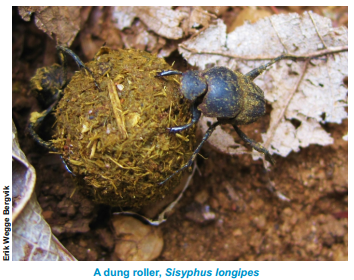
Dung beetles play an important ecological role in cultural landscapes like pastures, providing ecosystem services like nutrient cycling, disease control and secondary seed dispersal. Many Indian pastures have been replaced by agriculture or monoculture plantations, and more are under threat of being converted, although the Forest Rights Act from 2006 recognizes traditional rights to grazing. So, what happens to the dung beet l es when the pasture management changes? The main goal of my MSc fieldwork was to map the dung beetle communities of two simi l ar areas wi th di fferent grazi ng regimes, using a combination of baited pitfall traps and dung pats in an experimental setup. The fieldwork was conducted in the buffer region of KMTR tiger reserve, and I spent part of the time in ATREE's brand new field station near Singampatti. Arriving in the field, I was warmly welcomed by ATREE employees, who were a joy to get to know. I would never be able to finish my work if it had not been for the excellent support of everyone there, especially the two local field assistants, who with their tireless efforts helped me out along the way After the first days of actual fieldwork, I started to question whether a northerner like me really was cut out to do full days of physical labour in temperatures reaching 40 degrees. Luckily, my morale was high, and I had brought enough provisions of water. Not many days later, I felt more acclimatized, and thought no more of icebergs and glaciers. After identifying the specimen as far as my taxonomical skills allowed me to, the dung beetle experts Priyan and Seena at ATREE continued the ID-process. Back in Norway, data analysis began, calculating biodiversity indexes, the relation between species composition and other biotic components, and trap efficiency , amongst others. Family reasons and my full time job has unfortunately delayed the thesis, but it is in the making, and will be freely available online when completed. I learned a lot during my four month stay , not only about Indian dung beetles, but also of human life and culture in rural T amil Nadu. I also got useful insights in local and national politics, religion and environmental challenges. As a final remark, I want to thank all ATREEand ACCC field staff whom I met and worked with.
- Erik Wegge Bergvik
erik.wegge.bergvik@gmail.com
Tales from wilderness
Travails of a canopy ecologist
A wonderful sunrise and clear skies! Mutthu, (the ever-smiling assistant ) Mythri (the volunteer) and I ventured out to tree canopy . As a first, we had to rig the trees. So Mutthu and myself attach a carabiner to a nylon thread and haul it up. It gets stuck in the thick undergrowth. A hard tug and both the thread and my palm get cut. We set to rig the tree again using the sling. Six attempts later , the thread is up and I have a dozen cuts on my palm. Next, the climbing ropes are hauled up. I realize it's impossible to climb because the ropes are inclined at an angle. So attaching the harness to the rope, I haul it up thinking the weight will drag the rope towards the bole of the tree due to gravity . It gets stuck half way up! No amount of tugging helps budge it free. Muthu finally climbs another shorter tree to pull the rope back to the ground. Meanwhile, the thinner ropes used to haul the main rope and my backpack get entangled in leaf litter . It takes an hour to unwind the mess. It has been four hours since we began. Muthu and Mythri are up in the tree and I am almost there. At this moment my pen slips off from my pocket and goes down! Luckily , Giby comes along to see how we are doing and sends a pen up. The next five hours is spent recording epiphytes on the branches. For lunch we have bananas and water. Later at night, we spend two hours untangling the rigging thread. It dawns on me that those who pioneered this field of ecology were undoubtedly driven by a taste for high adventure and tenacity besides appreciating and understanding the beauty , diversity and complexity of interactions which take place in the forest canopy .
- Seshadri K.S.
seshadri.ali@gmail.com
Research Highlights
Population study of the fan throated lizard across the three variants
Despite their ubiquity across much of Peninsular India and Sri Lanka, fan-throated lizards remain relatively under-studied. Individuals across much of the range are currently classified as a single species, Si tana ponti ceri ana, despi te substanti al variation in the morphology of their throatfans. These throat-fans are used by males to di spl ay to and communi cate wi th other members of their species. It turns out that there are at least three dewlap variants, which occur, for the most part, in different locations in India. The throat-fan varies incrementally among these populations, from small to large and white to colourful. Southern Tamil Nadu (and Sri Lanka) is home to what I call the "intermediate-fan" variant, where the throat-fan is large but only partially coloured. The objective of my fieldwork over the last two years has been to see whether the three variants differ in display behaviour, the logic being that if you have different tools with which to communicate, then you would communicate differently. In 2012, I had visited populations of the white-fan variant and the coloured-fan variant, and had found substantial differences in both how they display and how often they display . I was excited to see how the intermediate-fan variant behaved. The Agasthyamalai Community-based Conservation Centre was the last of my seven fieldsites for this project, and I couldn't have picked a better place to finish! I worked in one of the three sites from where Michelle Logan reported about the home ranges of Sitana last year-an open, scrubby area behind the church on the road to Manimuthar. Lizards were plentiful, and displayed frequently from the tops of shrubs and rocks. The display behaviour of the intermediate-fan variant was in fact in between the behaviours of the white-fan and coloured-fan variants-they exhibit neither the characteristic head-bobbing of the white-fan variant, nor the head-twisting of the coloured-fan variant. I will be analysing my data over the next few months, but meanwhile the readers are welcome to watch some videos of the other variants at my website (ambikamath.wordpress.com/research).
- Ambika Kamath
ambikamath@gmail.com
Event Report
Community heritage tree mapping workshops
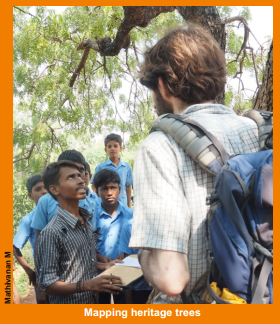
This winter the ACCC team have begun a new community based conservation project aimed at mapping heritage trees in the villages running along KMTR's eastern border. As part of this project we ran heritage tree mapping workshops on the 28th October and the 1 1th November in Ayan Singampatty. The first workshop took place at St Michael's School and was enthusiastically attended by the students there, while the second event was hosted by a local farmer with members of the local farming community attending. Heritage trees are mature and sacred trees of biodiversity and cultural importance, many of which are threatened in the rapidly developing landscape of KMTR buffer. With direct input from village community members this project aims to map such trees and produce a register for future conservation needs. As part of our first workshop the school children learned how to identify and record a heritage tree and mark its location on a map; a task they took to with great enthusiasm. In our second workshop the village farming community provided a wealth of information to the project regarding the location of heritage trees throughout the village. The fruits of both events have helped us thoroughly map the trees in the first village of the project. See latter issues for updates on further event and results.
- Keiran Flood
floodkw@gmail.com
Snippets:
- White necked stork was seen twice in the month of December, once near Kadana and once near Kalakadu. Mathivanan M. and Saravanan A.
- Seven to eight species of birds were seen nesting at Vagaikulam. In January , spoonbill nesting was reported for the first time. T . Ganesh and Prashant M.B.
- Thirty eight greater flamingos were seen at Karungulam in September. T . Ganesh, Mathivanan M., Saravanan A., and S. Tamizhazhagan.
- Several flocks of chestnut-bellied sandgrouse and a pair of Indian coursers seen in the grasslands of Vallanadu in January 2014. T . Ganesh and Prashant M.B.
- Pair of grey shrike which are becoming rare in the region was seen at Reddiarpatti scrub land off the NH-7 in December 2013. Prashant M. B. and T . Ganesh.
- Four to five red collared dove were sighted at the Vallanadu Blackbuck Sanctuary in the first week of January 2014. Prashant M. B. and T . Ganesh.
News, Talks and Presentations:
- Vivek R. was awarded a PhD for his thesis, "Effect of habitat alteration on canopy bird and small mammal communities in the wet evergreen forests of the Western Ghats".
- Mathivanan M. was invited to train Tamil Nadu Forest Department staffs and volunteers to identify wetland bird for a programme conducted by Tamil Nadu Forest Department, Tirunelveli region on November 23, 2013.
- Anna Spiller, an intern from Norway University is at the ACCC, working on bat guano quantification in temples.
- Kieran Flood, an intern from Ireland is at the ACCC, mapping heritage trees in buffer villages around KMTR.
- Todd Bertwell from the United States visited ACCC for developing a 'study abroad' programme.
- Mathivanan M. was invited to talk on conservation of fresh water ecosystem during a programme organized on October 15, 2013 by Zoo Outreach at Vickiramasingapuram in which 20 VFC members participated.
- Mathivanan M. was invited to address students from Sarah Tucker College, Palayamkottai during their visit to KMTR on flora and fauna of KMTR at a programme conducted by Tamil Nadu Forest Department, KMTR, Ambasamudram Range on October 4, 2013.
- A workshop on mapping trees was held on October 28, 2013 at St. Michael High School, Singampatti in which 20 students actively participated in mapping heritage trees of the school campus.
- A workshop on mapping trees was conducted at Ayan Singampatti village on November 12, 2013 in which 20 elders participated.
- ACCC received a grant from Tamil Nadu Forest Department, Thoothukudi Division to prepare water management plan for Vallanadu Blackbuck Sanctuary
- Annual Waterfowl Census 2014 has been tentatively scheduled between January 24-26, 2014. Interested volunteers people can contact Mathivanan M., Field Coordinator, ACCC
Publications:
- Abhisheka, K., J. Patrick David, M. B. Prashanth, K.S. Seshadri and T . Ganesh. 2013. First detailed survey of waterbirds in Tirunelveli and Tuticorin districts, Tamil Nadu, India. Journal of Threatened T axa, 5(12): 4641-4652 .
- Prashanth M. B., M. Mathivanan and T . Ganesh. 2013. Owls of the forest's edge. Sanctuary Asia. August 2013.
- Chetana, H.C., and T . Ganesh. 2013. Reconciling natural history and species ecology: Myristica beddomei (Myristicaceae), in the Western Ghats India. Tropical Conservation Science, 6:663-673.
- Lowman, M., S. Devy, and T . Ganesh. eds., 2013. Treetops at risk. Springer New York.

